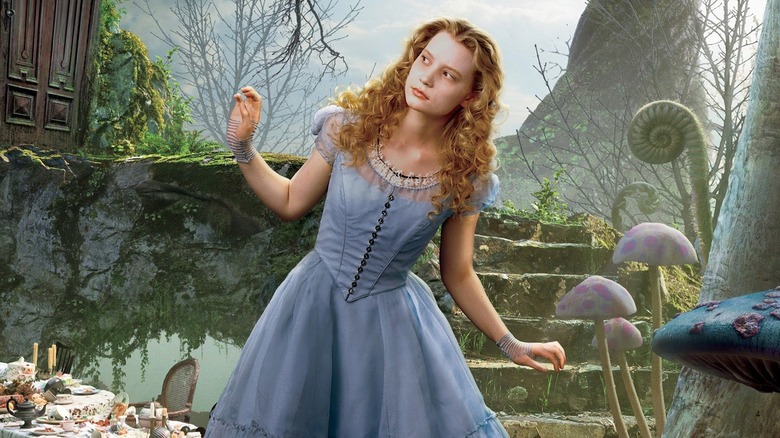Tim Burton is one of our most distinctive filmmakers. Whether you love him, hate him, or land somewhere in the middle, there is no denying that Burton has a voice and that voice has become rather valuable. From proving that “Batman” could be an A-tier superhero franchise to producing undeniable classics like “Beetlejuice,” he’s been making his mark on cinema for decades. Burton’s biggest moment came in 2010 when his live-action take on “Alice in Wonderland” hit theaters. Divisive though the movie may be, it made box office history at the time — and what’s more, it laid the groundwork for the next decade of blockbuster filmmaking in Hollywood, particularly at Disney.
In the modern era, a big blockbuster film making $1 billion or more at the box office is not all that uncommon. To date, 55 movies have made at least that much money worldwide. Rather crucially, though, the vast majority of those were released after “Alice in Wonderland,” which was only the sixth movie in history to cross the $1 billion mark. At the time, “Avatar,” “Titanic,” “The Lord of the Rings: Return of the King,” “Pirates of the Caribbean: Dead Man’s Chest” and “The Dark Knight” were the only other films that had accomplished such cinematic heights. Burton’s take on Lewis Carroll’s classic book was also the first spring release to get to that high watermark, arriving in theaters in March of 2010. It also benefited greatly from the 3D craze that was going on in that era.
All told, “Alice in Wonderland” made $1.025 billion, including $691.2 million overseas. At the time, that was a record for a Disney movie. It also posted the best opening weekend ever for a March released up to that point, with $116.1 million. Also of note, the only other non-sequels that had made more money worldwide at that time were James Cameron’s “Avatar” and “Titanic.” (Cameron has three of the top five highest-grossing films in history to his name, making him the unquestioned king of the box office.)
Be that as it may, this was Burton’s time to shine. This was a downright historic success for Disney. It was also not exactly a critical darling, which makes it all the more fascinating in hindsight.
Alice in Wonderland was the right movie at the right time
It simply cannot be overstated just how rare and unexpected this film’s success was at the time. Burton had made big movies before, yes, but nothing on this scale. We take it for granted now, but even the biggest of big blockbusters so rarely made such astronomical amounts of money. And it’s especially surprising given the divisive nature of the movie in question.
“Alice in Wonderland” was written by Linda Woolverton and almost serves as a sequel of sorts to Carroll’s book. The film centers on Alice (Mia Wasikowska), now 19 years old, who returns to the whimsical world she first entered as a child, embarking on a new journey. Many of Burton’s frequent collaborators were along for the ride, including Johnny Depp and Helena Bonham Carter.
For all of its financial success, Burton’s “Alice” holds a mere 50% critical approval rating on Rotten Tomatoes to go with an equally sour 55% audience score. Oftentimes, movies can overcome poor reviews if audiences get on board. 2018’s “Venom” ($856 million worldwide) is a spectacular example of that. In this case, though, the response from both critics and audiences was a bit mixed. That didn’t harm word of mouth at the time, paving the way for a historic run at the box office regardless.
More than anything, it was an example of the right movie at the right time. 3D was well suited to the material. Burton had built up a body of work that audiences had come to cherish. Overseas audiences were turning up for Hollywood movies in record numbers. The visuals in the film were extremely marketable. It was a perfect storm, one that would be difficult to replicate now or any time before this movie hit it big. Timing is often everything.
Alice in Wonderland kicked off a very profitable Disney trend
Reviews be damned, “Alice in Wonderland” prompted Disney to remake other animated classics in live-action. In the years that followed, remakes and new takes on classics such as “Beauty and the Beast,” “Cinderella,” “Maleficent,” “The Jungle Book,” “The Lion King,” and even a remake of “Dumbo” from Burton all hit theaters. Disney made more than $7 billion from these remakes between 2010 and 2019 until the pandemic upended the industry. Even now, stuff like “Mufasa: The Lion King” and a live-action “Lilo and Stitch” remake are on the way.
They weren’t all winners, with 2016’s “Alice Through the Looking Glass” ($299.8 million worldwide) making far less than its predecessor. Even so, it’s undeniable that the success of “Alice” was hugely consequential for Disney and the industry at large. If IP obsession was already taking off, this helped to supercharge that trend. For better or worse, this was an important moment in modern cinema history.
It also kickstarted one of the most prolific eras in Disney’s long, storied history. “Toy Story 3” also cleared more than $1 billion in 2010, making the Mouse House the first studio in history to have two $1 billion hits in a single year. In the years since, Disney has amassed 25 more $1 billion hits — by far the most of any other studio in Hollywood. And an awful lot of that can be traced back to this moment in time.
